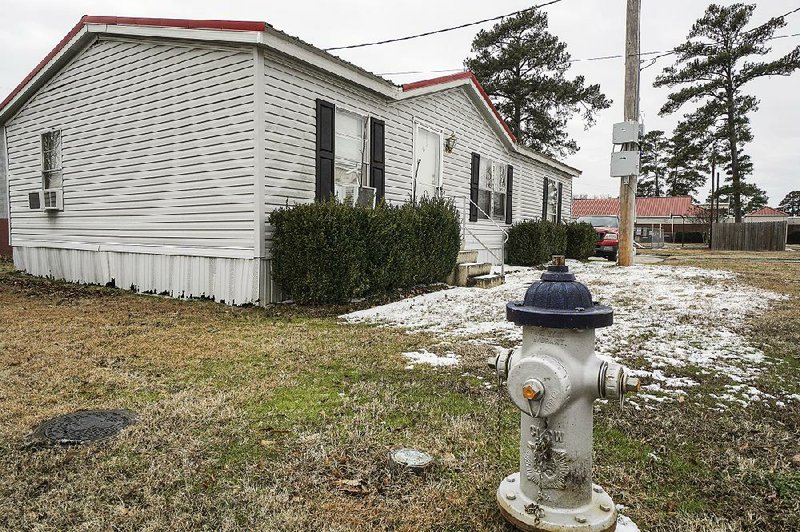Inside a Bryant fire station, a Folgers coffee tub collects change in the name of a longtime city goal. "NEW Station 3 Fund," a firefighter wrote on the side in black marker.
Right now, personnel at two of the city's three fire stations operate out of compact mobile homes. They've done so for almost a dozen years, Mayor Jill Dabbs said.
The homes were built in 2002 and have been occupied 24 hours a day, seven days a week since 2006, Bryant Fire Chief J.P. Jordan said.
That chapter is set to end next fall, when construction on two 8,300-square-foot permanent stations is completed.
At 10 a.m. today, city and fire officials will ceremonially break ground at 1601 S. Reynolds Road, the eventual site of the permanent Hill Farm station.
Another ceremony will be held at 10 a.m. Jan. 30 at the site for the Springhill station, 2620 Northlake Road.
Groundwork is already underway at both locations. Baldwin & Shell, the construction company, estimates that both facilities should be finished by November.
In 2006, the central station at 312 Roya Lane was completed, which is when firefighters began working around the clock.
Before, firefighters worked mostly day shifts, and only a couple of people manned the overnight shift. Now, teams of firefighters work for 24 hours, then take 48 hours off.
Personnel then began living in the two mobile units, at 200 SW Third St. and 2224 Justus Loop, Dabbs said.
The mobile homes were meant to last five years, but budget restraints for the rapidly expanding city prolonged the process for replacing them, Dabbs said.
However, "you can only go so long," she said.
In August 2016, Bryant citizens voted to extend a 0.5 percent sales tax that was first approved in 2006. This time, the money would pay for constructing the two fire stations, along with parks improvements and a new road.
"As you know, in the last 10 years, we've had incredible growth," Dabbs said.
In 2016, Bryant's population eclipsed 20,000. Between 2005 and 2030, the city and the surrounding area is projected to double in population.
Firefighter Clay Heslep described his second home, Station 2 on Southwest Third Street, as "kind of an eyesore." The mobile home sits in the same lot as Bryant City Hall.
With three bedrooms, including one that doubles as an office, and a living room that's crowded with refrigerators, there isn't much extra space, Heslep explained.
On the inside, it appears as if the builders "scabbed leftovers together," he said as he looked at the ceiling where two mismatched panels meet. One side of the home is plastered with floral wallpaper.
The central air conditioning went out two years ago, Lt. Kevin Smith said.
"If you want to do a sauna, you can pass it up and come here" in the summertime, he said.
Smith said he's looking forward to one perk at the new station in particular: "No more hot cots."
The mobile station has three beds for a rotation of nine firefighters. So after a shift, each firefighter must strip the sheets for the next person. A bed is always occupied.
"That's a cycle that never ends," Smith said.
The new stations will have five bedrooms with floor space for multiple beds, according to the blueprint designed by Black Corley Owens + Hughes Architects. Each station costs $2 million to $2.5 million when factoring in street and land improvements.
There will be a tool room, a workout room, office space, a lobby, four bathrooms, three pantries, a spacious living room and kitchen in each station, based on the blueprints.
Right now, a rack of barbells in Station 2 is wedged between two engines. Exhaust smoke blows onto the firefighters' turnout gear, the protective clothing they wear.
In the new stations, they'll have a designated room for turnouts so less smoke soaks into the fabric.
Heslep said he's excited to get an intercom system. Currently, firefighters hear every call for every station over the radio, not just their own, he said. It's tough for light sleepers, he added.
Smith, a 15-year veteran of the Fire Department, said the permanent stations will help retain personnel.
Right now, "we're training Little Rock's best firefighters," he said.
Some people mistakenly think a station is just a bunkhouse where firefighters sit and wait for nighttime calls, Heslep said.
But really, during the day, they move in and out. They examine buildings and schools, lead fire safety presentations and spend time "turning plugs," a term for inspecting fire hydrants, he said.
Plus, they eat, work out, sleep and recharge at the station.
"We call it a firehouse because it is our house," Heslep said. "We spend a third of our lives here."
Jordan, the fire chief, said he sees the new stations as a "morale builder."
As Bryant expands, its Fire Department expands with it. In less than 15 years, the department has transitioned from being a part-time operation to earning the highest fire protection classification: ISO 1. That goes into effect March 1, Jordan said.
The stations are "just a good move for us to position ourselves to grow over the coming years," he said.
And, Jordan added, he sees the need for a fourth station. One day.
Metro on 01/23/2018
